Scientists solve solar secret
Sunday, 27 March 2022 01:39 The further we move away from a heat source, the cooler the air gets. Bizarrely, the same can't be said for the Sun, but University of Otago scientists may have just explained a key part of why.
Study lead Dr Jonathan Squire, of the Department of Physics, says the surface of the Sun starts at 6000 degC, but over a short distance of only a few hundred kilometers, it suddenly heats up to mor
The further we move away from a heat source, the cooler the air gets. Bizarrely, the same can't be said for the Sun, but University of Otago scientists may have just explained a key part of why.
Study lead Dr Jonathan Squire, of the Department of Physics, says the surface of the Sun starts at 6000 degC, but over a short distance of only a few hundred kilometers, it suddenly heats up to mor Gilmour Space wins major grant to develop Australia's space manufacturing capability
Sunday, 27 March 2022 01:39 A $157 million bid led by Queensland-based Gilmour Space Technologies to grow sovereign space manufacturing in Australia has been awarded the largest Modern Manufacturing Initiative Collaboration (MMIC) grant for Space by the Federal Government.
Minister for Industry, Energy and Emissions Reduction Angus Taylor MP said in a statement that the Government's $52 million co-investment in the A
A $157 million bid led by Queensland-based Gilmour Space Technologies to grow sovereign space manufacturing in Australia has been awarded the largest Modern Manufacturing Initiative Collaboration (MMIC) grant for Space by the Federal Government.
Minister for Industry, Energy and Emissions Reduction Angus Taylor MP said in a statement that the Government's $52 million co-investment in the A High Throughput Satellites set to boom
Sunday, 27 March 2022 01:39 Euroconsult has released the 6th edition of its High Throughput Satellites (HTS) report - its in-depth analysis of geostationary (GEO) and non-geostationary (NGSO) HTS markets including major drivers, strategic issues, competitive landscape and detailed forecasts of capacity supply and associated demand take-up.
After helping reshape the satellite communications industry through their ever
Euroconsult has released the 6th edition of its High Throughput Satellites (HTS) report - its in-depth analysis of geostationary (GEO) and non-geostationary (NGSO) HTS markets including major drivers, strategic issues, competitive landscape and detailed forecasts of capacity supply and associated demand take-up.
After helping reshape the satellite communications industry through their ever Tailwind completes Terran Orbital acquisition process
Sunday, 27 March 2022 01:39 Tailwind Two Acquisition Corp. (NYSE: TWNT) has announced the completion of its business combination with Terran Orbital Corporation ("Terran Orbital"), a leading small satellite manufacturer primarily serving the United States aerospace and defense industry.
In connection with the completion of the business combination, Tailwind Two has been renamed Terran Orbital Corporation (the "Compan
Tailwind Two Acquisition Corp. (NYSE: TWNT) has announced the completion of its business combination with Terran Orbital Corporation ("Terran Orbital"), a leading small satellite manufacturer primarily serving the United States aerospace and defense industry.
In connection with the completion of the business combination, Tailwind Two has been renamed Terran Orbital Corporation (the "Compan French startup raises funding to develop solar sails
Saturday, 26 March 2022 21:52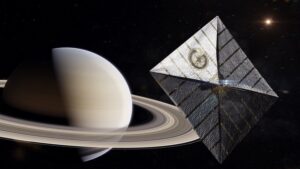
A French startup has raised an initial round of funding to begin testing of solar sails it believes can sharply reduce the cost of deep space missions.
The post French startup raises funding to develop solar sails appeared first on SpaceNews.
Intelsat rolls out network service that integrates Starlink and geostationary satellites
Saturday, 26 March 2022 19:53
Satellite operator Intelsat is offering a managed network service that integrates geostationary satellites, SpaceX’s Starlink low Earth orbit constellation and cellular broadband.
The post Intelsat rolls out network service that integrates Starlink and geostationary satellites appeared first on SpaceNews.
FAA again delays completion of Starship environmental review
Saturday, 26 March 2022 15:40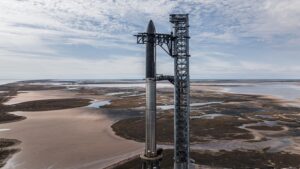
The FAA has again delayed completion of an environmental assessment for orbital launches of SpaceX’s Starship vehicle from Texas, although it may have no effect on near-term launch plans.
The post FAA again delays completion of Starship environmental review appeared first on SpaceNews.
SLS test could delay Crew Dragon launch
Friday, 25 March 2022 23:57
A practice countdown for NASA’s Space Launch System could cause a delay in the launch of a commercial mission to the International Space Station, a move with potential ripple effects for other missions to the station.
Terran Orbital stock cleared for trading on NYSE
Friday, 25 March 2022 22:16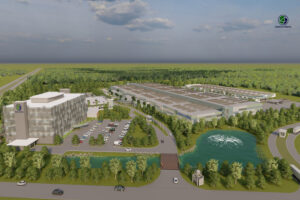
Shares in satellite manufacturer Terran Orbital Corp. were cleared to begin trading Monday on the New York Stock Exchange under the ticker symbol LLAP, Live Long and Prosper
The post Terran Orbital stock cleared for trading on NYSE appeared first on SpaceNews.
Additional funding unlikely to accelerate commercial space station projects
Friday, 25 March 2022 22:12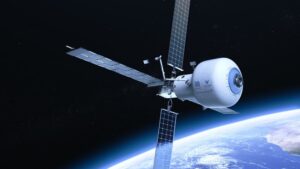
WASHINGTON — Companies developing commercial space station concepts for NASA say they’re working as fast as they can and that additional funding would not speed up their work significantly amid concerns about the long-term viability of the International Space Station.
Space Force using Spire data to detect satellite jamming
Friday, 25 March 2022 21:33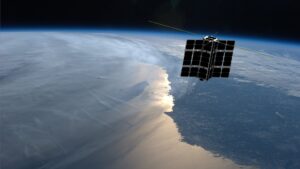
Spire is providing GPS telemetry data to help detect jamming as part of a project run by the U.S. Space Systems Command
The post Space Force using Spire data to detect satellite jamming appeared first on SpaceNews.
Week in images: 21 - 25 March 2022
Friday, 25 March 2022 13:10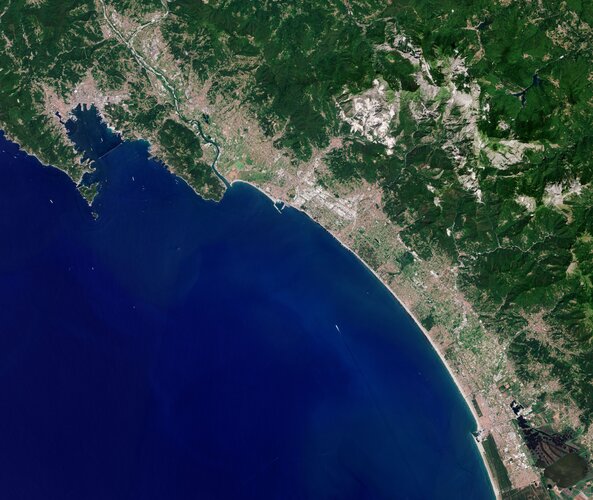
Week in images: 21 - 25 March 2022
Discover our week through the lens
Tiny satellites are changing the way we explore our planet and beyond
Friday, 25 March 2022 11:52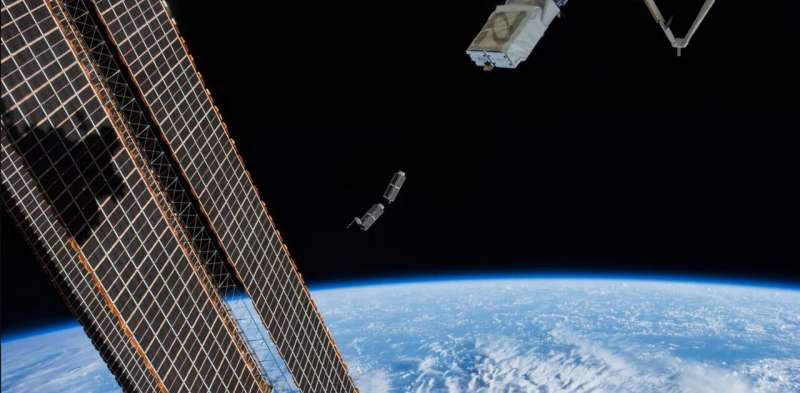
Want to go to space? It could cost you.
This month, the SpaceX Crew Dragon spacecraft will make the first fully-private, crewed flight to the International Space Station. The going price for a seat is US$55 million. The ticket comes with an eight-day stay on the space station, including room and board—and unrivaled views.
Virgin Galactic and Blue Origin offer cheaper alternatives, which will fly you to the edge of space for a mere US$250,000–500,000. But the flights only last between ten and 15 minutes, barely enough time to enjoy an in-flight snack.
But if you're happy to keep your feet on the ground, things start to look more affordable. Over the past 20 years, advances in tiny satellite technology have brought Earth orbit within reach for small countries, private companies, university researchers, and even do-it-yourself hobbyists.
Science in space
We are scientists who study our planet and the universe beyond. Our research stretches to space in search of answers to fundamental questions about how our ocean is changing in a warming world, or to study the supermassive black holes beating in the hearts of distant galaxies.
Webb's infrared universe
Friday, 25 March 2022 11:30 Video:
00:01:00
Video:
00:01:00
The James Webb Space Telescope (Webb) will observe the Universe in the near-infrared and mid-infrared – at wavelengths longer than visible light.
By viewing the Universe at infrared wavelengths with an unprecedented sensitivity Webb will open up a new window to the cosmos. With infrared wavelengths it can see the first stars and galaxies forming after the Big Bang. Its infrared vision also allows Webb to study stars and planetary systems forming inside thick clouds of gas and dust that are opaque to visible light.
The primary goals of Webb are to study galaxy, star and planet formation
Blow a Cosmic Kiss
Friday, 25 March 2022 09:39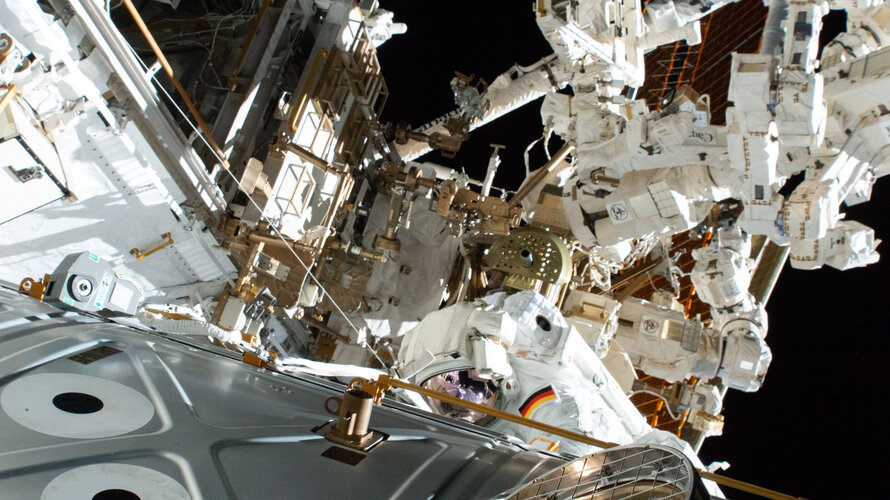 Image:
Image:
We spy from way up high an ESA astronaut dangling from the International Space Station.
Matthias Maurer performed his first spacewalk during his Cosmic Kiss mission yesterday with fellow astronaut Raja Chari of NASA. Extravehicular activity or EVA 80 lasted 6 hours and 54 minutes and was not without some excitement.
An hour into the spacewalk, the camera and light assembly on Matthias’ helmet needed some readjustments, which Raja was able to fix using some wiring. The duo were then able to carry on with the tasks, which included installing hoses on a radiator beam valve module that helps regulate Space

